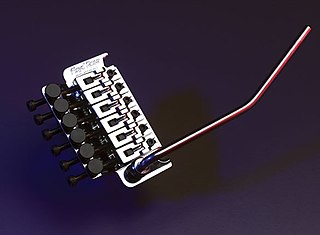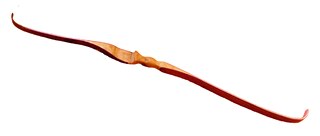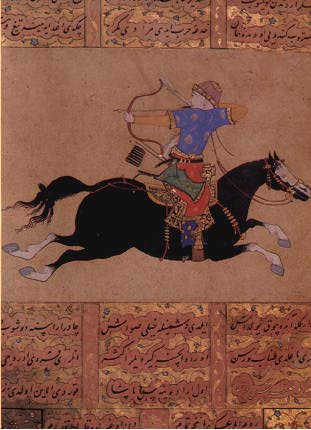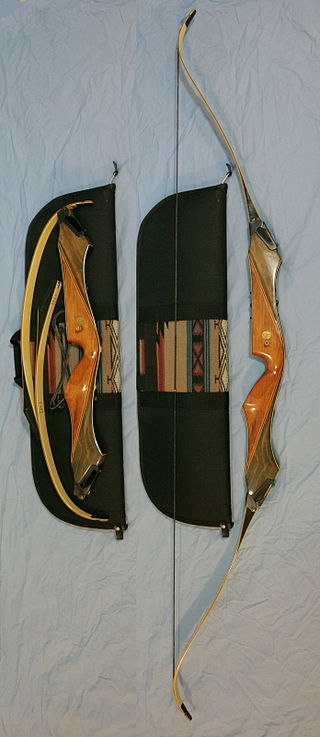Related Research Articles

Archery is the sport, practice, or skill of using a bow to shoot arrows. The word comes from the Latin arcus, meaning bow. Historically, archery has been used for hunting and combat. In modern times, it is mainly a competitive sport and recreational activity. A person who practices archery is typically called an archer, bowman, or toxophilite.

An arrow is a fin-stabilized projectile launched by a bow. A typical arrow usually consists of a long, stiff, straight shaft with a weighty arrowhead attached to the front end, multiple fin-like stabilizers called fletchings mounted near the rear, and a slot at the rear end called a nock for engaging the bowstring. A container or bag carrying additional arrows for convenient reloading is called a quiver.

In modern archery, a compound bow is a bow that uses a levering system, usually of cables and pulleys, to bend the limbs.

Kyūdō is the Japanese martial art of archery. Kyūdō is based on kyūjutsu, which originated with the samurai class of feudal Japan. In 1919, the name of kyūjutsu was officially changed to kyūdō, and following the example of other martial arts that have been systematizing for educational purposes, kyūdō also reorganized and integrated various forms of shooting that had been used up until then. High level experts in kyūdō may be referred to as kyūdōka (弓道家)(Kyudo Master) and some practitioners may refer to themselves as yumihiki (弓引き), or 'bow puller'. Kyūdō is practised by thousands of people worldwide. The bow they use is called a yumi (弓), and the most common one has an asymmetrical shape of more than 2.0 metres, and is characterized by the archer holding the part of the bow below the center to shoot the arrow.

The Floyd Rose Locking Tremolo, or simply Floyd Rose, is a type of locking vibrato arm for a guitar. Floyd D. Rose invented the locking vibrato in 1976, the first of its kind, and it is now manufactured by a company of the same name. The Floyd Rose gained popularity in the 1980s through guitarists like Eddie Van Halen, Neal Schon, Brad Gillis, Joe Satriani, Steve Vai, and Alex Lifeson, who used its ability to stay in tune even with extreme changes in pitch. Its tuning stability comes through the double-locking design that has been widely regarded as revolutionary; the design has been listed on Guitar World's "10 Most Earth Shaking Guitar Innovations" and Guitar Player's "101 Greatest Moments in Guitar History 1979–1983."

The bow and arrow is a ranged weapon system consisting of an elastic launching device (bow) and long-shafted projectiles (arrows). Humans used bows and arrows for hunting and aggression long before recorded history, and the practice was common to many prehistoric cultures. They were important weapons of war from ancient history until the early modern period, where they were rendered increasingly obsolete by the development of the more powerful and accurate firearms. Today, bows and arrows are mostly used for hunting and sports.

In archery, the shape of the bow is usually taken to be the view from the side. It is the product of the complex relationship of material stresses, designed by a bowyer. This shape, viewing the limbs, is designed to take into account the construction materials, the performance required, and the intended use of the bow.

A longbow is a type of tall bow that makes a fairly long draw possible. A longbow is not significantly recurved. Its limbs are relatively narrow and are circular or D-shaped in cross section. Flatbows can be just as long, but in cross-section, a flatbow has limbs that are approximately rectangular.

A thumb ring is a ring meant to be worn on one's thumb. Most commonly, thumb rings are used as an archery equipment designed to protect the thumb pulp from the bowstring during a thumb draw, and are made of leather, stone, horn, wood, bone, antler, ivory, metal, ceramics, plastic or glass. It usually fits over the distal phalanx of the thumb, coming to rest at the distal edge of the interphalangeal joint. Typically a flange extends from the ring to cover the thumb pulp, and may be supplemented by a leather extension.

Turkish archery is a tradition of archery which became highly developed in the Ottoman Empire, although its origins date back to the Eurasian Steppe in the second millennium BC.

Dry firing is the practice of simulating the discharge of a firearm without any live ammunition, or practicing with an inert laser/infrared training platform and may also include the use of a target/feedback system. The terms also commonly refers to simply "firing" a gun that has no ammunition in it. Concern is commonly expressed that doing so might damage the gun.

A bowstring joins the two ends of the bow stave and launches the arrow. Desirable properties include light weight, strength, resistance to abrasion, and resistance to water. Mass has most effect at the center of the string; one gram (0.035 oz) of extra mass in the middle of the string slows the arrow about as much as 3.5 grams (0.12 oz) at the ends.
A bow draw in archery is the method or technique of pulling back the bowstring to store energy for the bow to shoot an arrow. The most common method in modern target archery is the Mediterranean draw, which has long been the usual method in European archery. Other methods include the pinch draw and the Mongolian or "thumb" draw. In traditional archery practice outside Western Europe the variations of the thumb draw are by far the most dominant draw types, with the Mediterranean draw restricted to the Olympic style of target archery.
This is a list of archery terms, including both the equipment and the practice. A brief description for each word or phrase is also included.

In archery, a recurve bow is one of the main shapes a bow can take, with limbs that curve away from the archer when unstrung. A recurve bow stores more energy and delivers energy more efficiently than the equivalent straight-limbed bow, giving a greater amount of energy and speed to the arrow. A recurve will permit a shorter bow than the simple straight limb bow for given arrow energy, and this form was often preferred by archers in environments where long weapons could be cumbersome, such as in brush and forest terrain, or while on horseback.
In archery, a release aid, mechanical release, or release is a device that helps to fire arrows more precisely, by using a trigger to release the bowstring, rather than the archer's fingers. It is used to make the release of the bowstring quicker and reducing the amount of torque put onto the bowstring from the archer's fingers.

In archery, a stabiliser is a general term for various types of weights, usually on rods, mounted on the bow to increase stability i.e. lessen movement on release, thereby increasing precision. Stabilisers help reduce inconsistency in the archer's release by increasing the moment of inertia of the bow. If the shooting technique of the archer were perfect, no stabilisers would be required.

Para-archery classification is the classification system for para-archery used to create a level playing field for archers with a different range of disabilities. Governance in the sport is through the International Archery Federation. Early classification systems for the sport were created during the 1940s and based on medical classification. This has subsequently changed to a functional mobility classification with the exception of blind archery.
Hoyt Archery is an American manufacturer of recurve and compound bows located in Salt Lake City, Utah. Most notable for their competition recurve bows, which are featured prominently in the Olympics; every gold medalist in individual archery at the 2012 Summer Olympics shot a Hoyt recurve. Hoyt is owned by Jas. D. Easton, Inc.

A takedown bow is a bow assembled out of a riser and two limbs to make a working bow when strung.
References
- ↑ "US Patent 7305979". Patentstorm.us. Archived from the original on 19 March 2012. Retrieved 1 August 2012.
- ↑ "Compound Bow Selection Guide: Cam Type" . Retrieved 1 August 2012.
- ↑ "Compound Bow Selection Guide - Hunter's Friend Archery". www.huntersfriend.com. Retrieved 2016-04-22.
- ↑ "Wheel Options" . Retrieved 1 August 2012.
- ↑ "2007 Compound Bow Specifications". Archived from the original on 19 August 2012. Retrieved 1 August 2012.